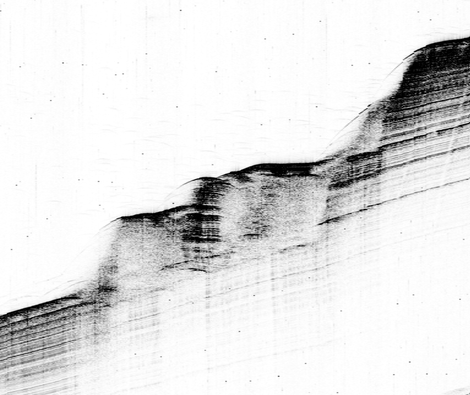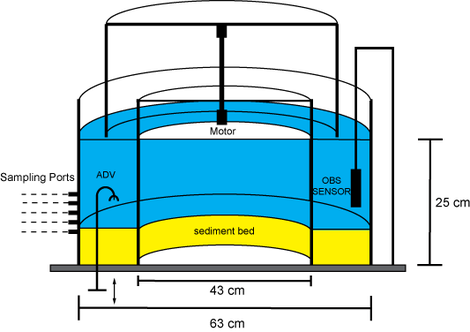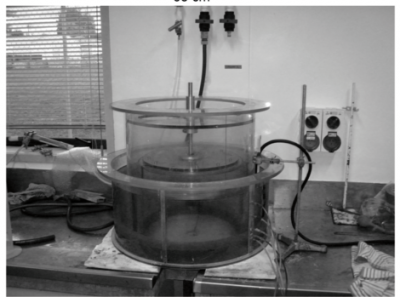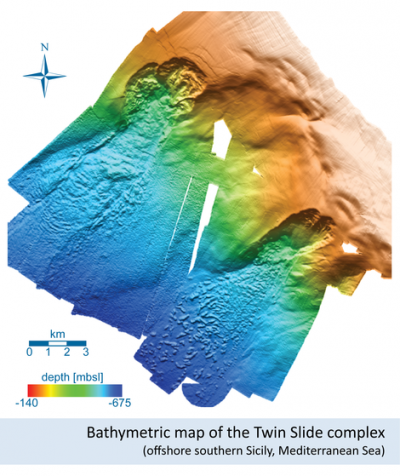Page path:
- Modelling of Sedimentation Processes
- Sediment Transport
Sediment Transport

Submarine Mass Movements
Transporting sediment across the shelf into the deep ocean, submarine landslides represent an integral component in the evolution of continental margins. At the same time they pose significant risks to the coastal population, e.g. through destruction of offshore infrastructure and tsunami generation. By analysing marine archives and their physico-chemical properties as well as acoustic datasets, we investigate the dynamics and failure mechanisms of submarine landslides.

Acoustic profile over failure zone (Parasound)

Annular Flume Tank
The annular laboratory flume we use is constructed with dimensions according to Widdows et al. (1998). The circular channel is 10 cm wide and bounded by an outer (63 cm) and inner (43 cm) rim, resulting in a bed area of 0.17 m². At the maximum water level of 25 cm, 40 liters of artificial seawater (S = 30) can be accommodated in the flume. A removable, rotating lid (45 cm diameter) driven by a 12 V motor was mounted on top of the flume, which caused a current motion of up to 0.30 m/s (55 rotations per minute; 1 is 0.00526 m/s (Jones et al. 2011)). The motor speed is controlled by a computer which allowed the controlled variation of the flume flow speeds. Furthermore, the concentration of suspended particulate matter (SPM) in the water column can be recorded by an optical back-scatter sensor above the sediment bed. In order to map the boundary-layer dynamics in the flume and to parameterize the bed shear stress a downward-looking SonTek MicroAcoustic Doppler Velocimeter (ADV) can be installed in the channel. Therefore, the ADV can be mounted onto a vertical racking system through the base plate into the middle of the channel (Jones et al. 2011). For further information refer to Prof. Dr. Conrad Pilditch, University of Waikato, New Zealand.


Schematic and photograph of the annular flume tank. Stored in the Aquatic Research Center of the University of Waikato, Hamilton, New Zealand.

Current Projects
Franziska Staudt
Initiation of motion: investigating sediment remobilization processes combining lab flume tank experiments, field measurement and numerical simulations
Describing sediment erosion is an important factor for the understanding of coastal processes. Erosion, i.e. the movement of single sediment grains, is initiated when the hydrodynamic driving force outweighs the grain resistance force. In addition to the flow field and the grain size and weight, other key parameters play a role in the initiation of motion: cohesive forces in between particles, stabilization or destabilization through biological activity, or so-called caging structures, i.e. textural induced structures of fine particles (clay) encompassing coarser sand grains (Le Hir et al. 2008, Mitchener and Torfs, 1996).
Describing sediment erosion is an important factor for the understanding of coastal processes. Erosion, i.e. the movement of single sediment grains, is initiated when the hydrodynamic driving force outweighs the grain resistance force. In addition to the flow field and the grain size and weight, other key parameters play a role in the initiation of motion: cohesive forces in between particles, stabilization or destabilization through biological activity, or so-called caging structures, i.e. textural induced structures of fine particles (clay) encompassing coarser sand grains (Le Hir et al. 2008, Mitchener and Torfs, 1996).
| More details about the project on INTERCOAST |
Jannis Kuhlmann
To which extend do sediment physical parameters control (I) slope failure and (II) transport mechanisms? - The /Twin Slides/ offshore southern Sicily serving as a unique case study area
The phenomena of submarine landslides and their inherent consequences occur at all margins worldwide. Many studies have mapped and monitored slides and investigated trigger mechanisms and sediment failure processes. Still, great uncertainty persists as to why a given slope fails whereas another adjacent remains stable. In this context, augmented focus is put on events of smaller scale such as the Twin Slide complex offshore southern Sicily in the highly vulnerable oceanic basin of the Mediterranean Sea.
Main objective of the PhD project is the development and evaluation of conceptional models for the evolution of the Twin Slide complex. Analysis of both geophysical data and long MeBo and shorter gravity cores acquired during research cruise MSM15/3, aligned with numerical modelling experiments, encompass the investigative framework to address the following questions:
(A) Which conceptional model fits best to the evolution of the Twin Slide complex?
(B) Do highly porous ash layers serve as potential failure and glide planes of submarine mass movements? Can specific stratigraphic surfaces be identified that act as glide planes (e.g. clay-rich and/or porous ash layers with high liquefaction potential)?
(C) Do and how do sediment-physical parameters of source material control transport mechanisms?
The phenomena of submarine landslides and their inherent consequences occur at all margins worldwide. Many studies have mapped and monitored slides and investigated trigger mechanisms and sediment failure processes. Still, great uncertainty persists as to why a given slope fails whereas another adjacent remains stable. In this context, augmented focus is put on events of smaller scale such as the Twin Slide complex offshore southern Sicily in the highly vulnerable oceanic basin of the Mediterranean Sea.
Main objective of the PhD project is the development and evaluation of conceptional models for the evolution of the Twin Slide complex. Analysis of both geophysical data and long MeBo and shorter gravity cores acquired during research cruise MSM15/3, aligned with numerical modelling experiments, encompass the investigative framework to address the following questions:
(A) Which conceptional model fits best to the evolution of the Twin Slide complex?
(B) Do highly porous ash layers serve as potential failure and glide planes of submarine mass movements? Can specific stratigraphic surfaces be identified that act as glide planes (e.g. clay-rich and/or porous ash layers with high liquefaction potential)?
(C) Do and how do sediment-physical parameters of source material control transport mechanisms?

Gerhard Bartzke
Micro scale sediment - fluid interactions
Sediment erosion is understood as the initiation of motion of single grains by a hydrodynamic driving force. Most classical studies have attempted to predict sediment erosion as a function of single grain size at a defined flow force, e.g., Shields (1936) and Hjulstroem (1935). However, at present, it is understood that the erosion behavior of sediments is also controlled by additional factors that shift the initial erosion conditions towards higher regimes.
Sediment erosion is understood as the initiation of motion of single grains by a hydrodynamic driving force. Most classical studies have attempted to predict sediment erosion as a function of single grain size at a defined flow force, e.g., Shields (1936) and Hjulstroem (1935). However, at present, it is understood that the erosion behavior of sediments is also controlled by additional factors that shift the initial erosion conditions towards higher regimes.
| More details about the project on INTERCOAST |



